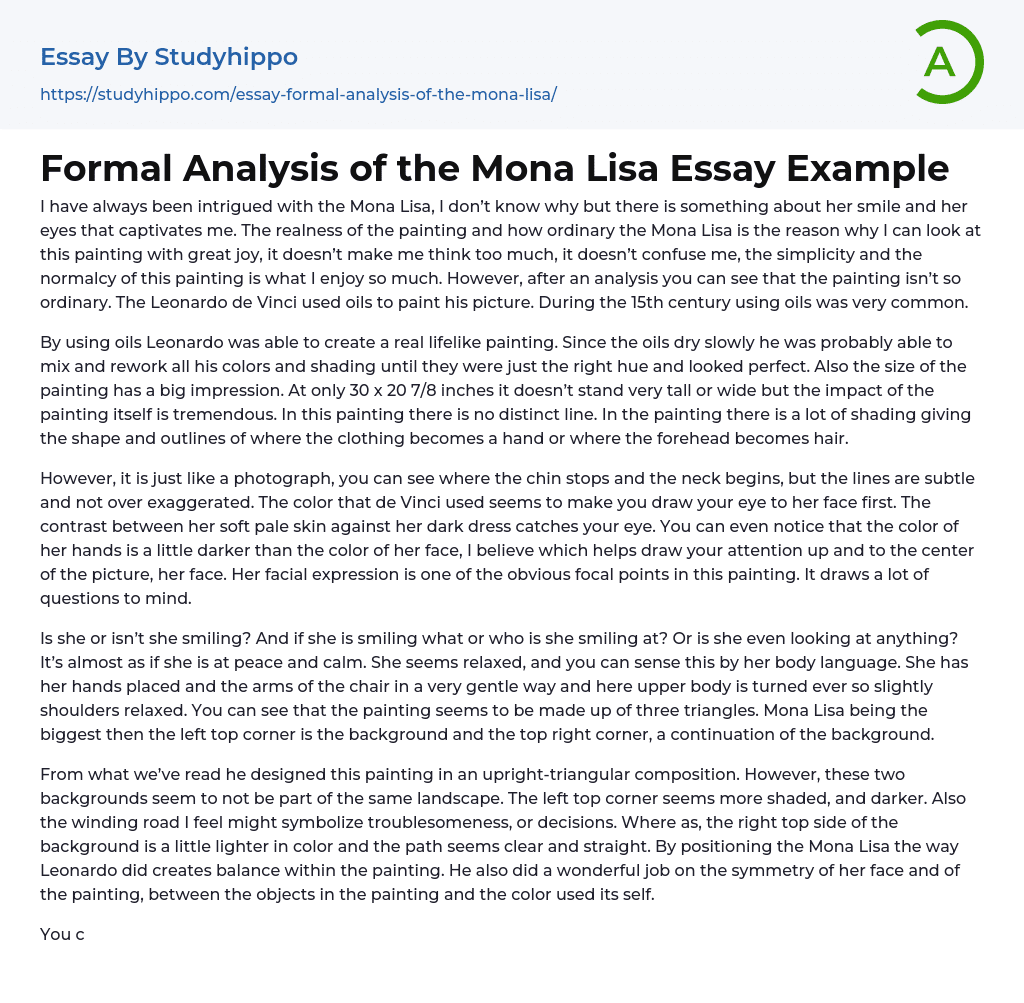I have always been intrigued with the Mona Lisa, I don’t know why but there is something about her smile and her eyes that captivates me. The realness of the painting and how ordinary the Mona Lisa is the reason why I can look at this painting with great joy, it doesn’t make me think too much, it doesn’t confuse me, the simplicity and the normalcy of this painting is what I enjoy so much. However, after an analysis you can see that the painting isn’t so ordinary. The Leonardo de Vinci used oils to paint his picture. During the 15th century using oils was very common.
By using oils Leonardo was able to create a real lifelike painting. Since the oils dry slowly he was probably able to mix and rework all his colors and shad
...ing until they were just the right hue and looked perfect. Also the size of the painting has a big impression. At only 30 x 20 7/8 inches it doesn’t stand very tall or wide but the impact of the painting itself is tremendous. In this painting there is no distinct line. In the painting there is a lot of shading giving the shape and outlines of where the clothing becomes a hand or where the forehead becomes hair.
However, it is just like a photograph, you can see where the chin stops and the neck begins, but the lines are subtle and not over exaggerated. The color that de Vinci used seems to make you draw your eye to her face first. The contrast between her soft pale skin against her dark dress catches your eye. You can even notice
that the color of her hands is a little darker than the color of her face, I believe which helps draw your attention up and to the center of the picture, her face. Her facial expression is one of the obvious focal points in this painting. It draws a lot of questions to mind.
Is she or isn’t she smiling? And if she is smiling what or who is she smiling at? Or is she even looking at anything? It’s almost as if she is at peace and calm. She seems relaxed, and you can sense this by her body language. She has her hands placed and the arms of the chair in a very gentle way and here upper body is turned ever so slightly shoulders relaxed. You can see that the painting seems to be made up of three triangles. Mona Lisa being the biggest then the left top corner is the background and the top right corner, a continuation of the background.
From what we’ve read he designed this painting in an upright-triangular composition. However, these two backgrounds seem to not be part of the same landscape. The left top corner seems more shaded, and darker. Also the winding road I feel might symbolize troublesomeness, or decisions. Where as, the right top side of the background is a little lighter in color and the path seems clear and straight. By positioning the Mona Lisa the way Leonardo did creates balance within the painting. He also did a wonderful job on the symmetry of her face and of the painting, between the objects in the painting and the color used its self.
You can see that
when viewing a painting like this there are many questions that arise in your mind. Looking at the Mona Lisa I get drawn in and a sense of wonderment comes over me. I start to imagine the person in the painting and what her smile was really about. A strong, confident women is what I think she was, and that was brought out beautifully by de Vinci. I also think that the way he painted the Mona Lisa shows a lot about what and how Leonardo viewed women. Many say that it was painted for the love of his mother. What do you think?
- Aldous Huxley essays
- Alice Walker essays
- Amy tan essays
- Anne Bradstreet essays
- Anton Chekhov essays
- Arthur Miller essays
- Augustine essays
- Bertolt Brecht essays
- Booker T Washington essays
- Carol ann duffy essays
- Charles Dickens essays
- Charlotte Perkins Gilman essays
- Chinua Achebe essays
- Christina Rossetti essays
- Consider The Lobster essays
- Edgar Allan Poe essays
- Elizabeth Bishop essays
- Emily Dickinson essays
- Ernest Hemingway essays
- F. Scott Fitzgerald essays
- George Orwell essays
- Harper Lee essays
- Homer essays
- James Baldwin essays
- Jane Austen essays
- John Donne essays
- John Steinbeck essays
- Kate Chopin essays
- Kurt Vonnegut essays
- Langston Hughes essays
- Leonardo Da Vinci essays
- Mark Twain essays
- Mary Shelley essays
- Maya Angelou essays
- Nathaniel Hawthorne essays
- Oscar Wilde essays
- Percy Bysshe Shelley essays
- Peter Skrzynecki essays
- Phillis Wheatley essays
- Poets essays
- Ralph Waldo Emerson essays
- Ray Bradbury essays
- Richard Rodriguez essays
- Robert Browning essays
- Robert Frost essays
- Robert Louis Stevenson essays
- Seamus Heaney essays
- Sherman Alexie essays
- Sophocles essays
- Stephen King essays




